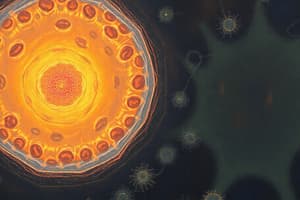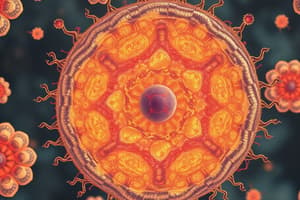Podcast
Questions and Answers
Which of the following is a primary function performed by all cells?
Which of the following is a primary function performed by all cells?
- Differentiation into specialized tissues
- Nutrition involving transformation of substances into energy (correct)
- Regeneration of damaged organs
- Photosynthesis
What distinguishes unicellular organisms from pluricellular organisms?
What distinguishes unicellular organisms from pluricellular organisms?
- Unicellular organisms consist of one cell, while pluricellular organisms consist of many cells. (correct)
- Unicellular organisms are visible with the naked eye, whereas pluricellular organisms are microscopic.
- Unicellular organisms are always prokaryotic, while pluricellular organisms are always eukaryotic.
- Unicellular organisms can perform reproduction, but pluricellular organisms cannot.
Which characteristic is fundamental to prokaryotic cells?
Which characteristic is fundamental to prokaryotic cells?
- Presence of a membrane-bound nucleus containing DNA
- Ability to differentiate into various tissue types
- Large size, visible without a microscope
- DNA is dispersed throughout the cytoplasm. (correct)
How does the organization of genetic material differ between prokaryotic and eukaryotic cells?
How does the organization of genetic material differ between prokaryotic and eukaryotic cells?
What is the significance of a cell's 'relationship' function?
What is the significance of a cell's 'relationship' function?
Which of the following best describes the role of the 'reproduction' function in cells?
Which of the following best describes the role of the 'reproduction' function in cells?
Which of the following characteristics is exclusive to eukaryotic cells?
Which of the following characteristics is exclusive to eukaryotic cells?
Which type of cell is typically found in trees, animals and human beings?
Which type of cell is typically found in trees, animals and human beings?
A scientist discovers a new unicellular organism. After examining its cellular structure, they find no nucleus is present. How should this organism be classified?
A scientist discovers a new unicellular organism. After examining its cellular structure, they find no nucleus is present. How should this organism be classified?
In what fundamental way do plant and animal cells differ from bacteria?
In what fundamental way do plant and animal cells differ from bacteria?
If a cell's ability to perform nutrition is compromised, what direct consequence will it face?
If a cell's ability to perform nutrition is compromised, what direct consequence will it face?
Which of the following cellular components is common to both prokaryotic and eukaryotic cells?
Which of the following cellular components is common to both prokaryotic and eukaryotic cells?
What is a key difference in how prokaryotic and eukaryotic cells handle the 'reproduction' process?
What is a key difference in how prokaryotic and eukaryotic cells handle the 'reproduction' process?
Why is the 'relationship' function crucial for a cell's survival?
Why is the 'relationship' function crucial for a cell's survival?
Which type of cell is more likely to form complex, multicellular organisms?
Which type of cell is more likely to form complex, multicellular organisms?
A cell is exposed to a toxin that damages its outer envelope. What function would be MOST immediately affected?
A cell is exposed to a toxin that damages its outer envelope. What function would be MOST immediately affected?
How does the absence of a nucleus in prokaryotic cells affect their ability to perform complex functions?
How does the absence of a nucleus in prokaryotic cells affect their ability to perform complex functions?
If a scientist introduces a mutation that impairs relationship functions, what outcome is most likely?
If a scientist introduces a mutation that impairs relationship functions, what outcome is most likely?
Which statement accurately compares cell size and visibility?
Which statement accurately compares cell size and visibility?
What is the distinguishing feature between plant and animal eukaryotic cells
What is the distinguishing feature between plant and animal eukaryotic cells
Flashcards
What is a cell?
What is a cell?
The smallest unit of life capable of performing life functions.
What is cell nutrition?
What is cell nutrition?
Transforming substances into energy for the cell's use.
What is cell relationship?
What is cell relationship?
Responding and interacting with stimuli from the surroundings.
What is cell reproduction?
What is cell reproduction?
Signup and view all the flashcards
What are unicellular beings?
What are unicellular beings?
Signup and view all the flashcards
What are pluricellular beings?
What are pluricellular beings?
Signup and view all the flashcards
What is a prokaryotic cell?
What is a prokaryotic cell?
Signup and view all the flashcards
What is a eukaryotic cell?
What is a eukaryotic cell?
Signup and view all the flashcards
Study Notes
- A cell constitutes the smallest unit in living beings.
- Cells are too small for naked eye observation.
- Cells exhibit varied shapes.
- All cells have an external envelope and an aqueous interior housing various organelles.
- Cells execute nutrition, relationship, and reproduction.
- Nutrition transforms substances into energy.
- Relationship involves interacting with environmental stimuli.
- Reproduction directs growth and division.
- Living organisms are either unicellular or pluricellular, based on cell number.
- Unicellular organisms consist of a single cell, like bacteria.
- Pluricellular organisms consist of numerous cells, examples include trees, animals, and humans.
- Cells are classified as prokaryotic or eukaryotic based on their structure.
- Prokaryotic cells feature DNA dispersed in the cytoplasm, lacking a nucleus; bacteria exemplify this type.
- Eukaryotic cells contain a nucleus, bounded by a membrane, that houses DNA, which carries genetic material.
- Eukaryotic cells include vegetal and animal types.
Studying That Suits You
Use AI to generate personalized quizzes and flashcards to suit your learning preferences.




